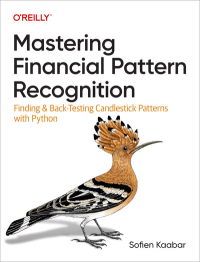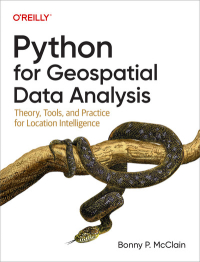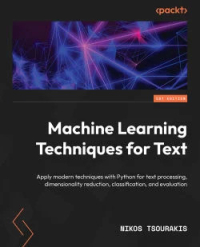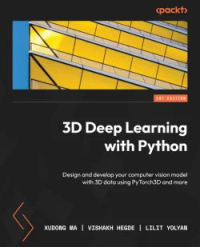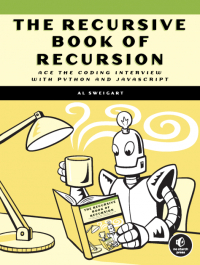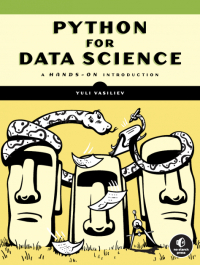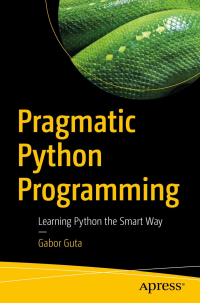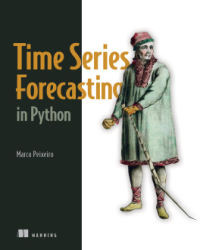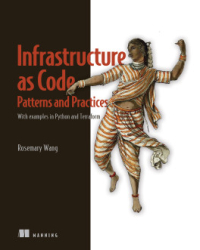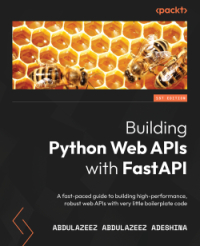Python eBooks
Mastering Financial Pattern Recognition
Candlesticks have become a key component of platforms and charting programs for financial trading. With these charts, traders can learn underlying patterns for interpreting price action history and forecasts. This A-Z guide shows portfolio managers, quants, strategists, and analysts how to use Python to recognize, scan, trade, and back-test the profitability of candlestick patterns. Financial author, trading consultant, and institutional market strategist Sofien Kaabar shows you how to create a candlestick scanner and indicator so you can compare the profitability of these patterns. With this hands-on book, you'll also explore a new type of charting system similar to candlesticks, as well as new patterns that have never been presented before. ...
Candlesticks have become a key component of platforms and charting programs for financial trading. With these charts, traders can learn underlying patterns for interpreting price action history and forecasts. This A-Z guide shows portfolio managers, quants, strategists, and analysts how to use Python to recognize, scan, trade, and back-test the profitability of candlestick patterns. Financial author, trading consultant, and institutional market strategist Sofien Kaabar shows you how to create a candlestick scanner and indicator so you can compare the profitability of these patterns. With this hands-on book, you'll also explore a new type of charting system similar to candlesticks, as well as new patterns that have never been presented before. ...
Python for Geospatial Data Analysis
In spatial data science, things in closer proximity to one another likely have more in common than things that are farther apart. With this practical book, geospatial professionals, data scientists, business analysts, geographers, geologists, and others familiar with data analysis and visualization will learn the fundamentals of spatial data analysis to gain a deeper understanding of their data questions. Author Bonny P. McClain demonstrates why detecting and quantifying patterns in geospatial data is vital. Both proprietary and open source platforms allow you to process and visualize spatial information. This book is for people familiar with data analysis or visualization who are eager to explore geospatial integration with Python. ...
In spatial data science, things in closer proximity to one another likely have more in common than things that are farther apart. With this practical book, geospatial professionals, data scientists, business analysts, geographers, geologists, and others familiar with data analysis and visualization will learn the fundamentals of spatial data analysis to gain a deeper understanding of their data questions. Author Bonny P. McClain demonstrates why detecting and quantifying patterns in geospatial data is vital. Both proprietary and open source platforms allow you to process and visualize spatial information. This book is for people familiar with data analysis or visualization who are eager to explore geospatial integration with Python. ...
Modern Full-Stack Development, 2nd Edition
Explore what React, Node, Python Django, TypeScript, Webpack, and Docker have to offer individually, and how they all fit together in modern app development. This updated version will show you how to build apps with React, Node.js or Django, and TypeScript, and how Webpack can be used to optimize and organize your code for deployment. You'll begin by building a solid foundation of knowledge and quickly expand it by constructing three different real-world apps. These aren't just simple, contrived examples but real apps that you can choose to install on your servers and use for real. You'll also understand how Docker can be used to run the apps you build in a clear and well-defined way, all of which will be able to springboard you into creating more advanced apps on your own. You'll see why React is one of the most popular web development tools available today, and why Node.js is also frequently used for server-side development. The fact that both utilize JavaScript is a big ...
Explore what React, Node, Python Django, TypeScript, Webpack, and Docker have to offer individually, and how they all fit together in modern app development. This updated version will show you how to build apps with React, Node.js or Django, and TypeScript, and how Webpack can be used to optimize and organize your code for deployment. You'll begin by building a solid foundation of knowledge and quickly expand it by constructing three different real-world apps. These aren't just simple, contrived examples but real apps that you can choose to install on your servers and use for real. You'll also understand how Docker can be used to run the apps you build in a clear and well-defined way, all of which will be able to springboard you into creating more advanced apps on your own. You'll see why React is one of the most popular web development tools available today, and why Node.js is also frequently used for server-side development. The fact that both utilize JavaScript is a big ...
Machine Learning Techniques for Text
With the ever-increasing demand for machine learning and programming professionals, it's prime time to invest in the field. This book will help you in this endeavor, focusing specifically on text data and human language by steering a middle path among the various textbooks that present complicated theoretical concepts or focus disproportionately on Python code. A good metaphor this work builds upon is the relationship between an experienced craftsperson and their trainee. Based on the current problem, the former picks a tool from the toolbox, explains its utility, and puts it into action. This approach will help you to identify at least one practical use for each method or technique presented. The content unfolds in ten chapters, each discussing one specific case study. For this reason, the book is solution-oriented. It's accompanied by Python code in the form of Jupyter notebooks to help you obtain hands-on experience. A recurring pattern in the chapters of this book ...
With the ever-increasing demand for machine learning and programming professionals, it's prime time to invest in the field. This book will help you in this endeavor, focusing specifically on text data and human language by steering a middle path among the various textbooks that present complicated theoretical concepts or focus disproportionately on Python code. A good metaphor this work builds upon is the relationship between an experienced craftsperson and their trainee. Based on the current problem, the former picks a tool from the toolbox, explains its utility, and puts it into action. This approach will help you to identify at least one practical use for each method or technique presented. The content unfolds in ten chapters, each discussing one specific case study. For this reason, the book is solution-oriented. It's accompanied by Python code in the form of Jupyter notebooks to help you obtain hands-on experience. A recurring pattern in the chapters of this book ...
3D Deep Learning with Python
With this hands-on guide to 3D deep learning, developers working with 3D computer vision will be able to put their knowledge to work and get up and running in no time. Complete with step-by-step explanations of essential concepts and practical examples, this book lets you explore and gain a thorough understanding of state-of-the-art 3D deep learning. You'll see how to use PyTorch3D for basic 3D mesh and point cloud data processing, including loading and saving ply and obj files, projecting 3D points into camera coordination using perspective camera models or orthographic camera models, rendering point clouds and meshes to images, and much more. As you implement some of the latest 3D deep learning algorithms, such as differential rendering, Nerf, synsin, and mesh RCNN, you'll realize how coding for these deep learning models becomes easier using the PyTorch3D library. By the end of this deep learning book, you'll be ready to implement your own 3D deep learning models confidently. ...
With this hands-on guide to 3D deep learning, developers working with 3D computer vision will be able to put their knowledge to work and get up and running in no time. Complete with step-by-step explanations of essential concepts and practical examples, this book lets you explore and gain a thorough understanding of state-of-the-art 3D deep learning. You'll see how to use PyTorch3D for basic 3D mesh and point cloud data processing, including loading and saving ply and obj files, projecting 3D points into camera coordination using perspective camera models or orthographic camera models, rendering point clouds and meshes to images, and much more. As you implement some of the latest 3D deep learning algorithms, such as differential rendering, Nerf, synsin, and mesh RCNN, you'll realize how coding for these deep learning models becomes easier using the PyTorch3D library. By the end of this deep learning book, you'll be ready to implement your own 3D deep learning models confidently. ...
The Recursive Book of Recursion
Recursion has an intimidating reputation: it's considered to be an advanced computer science topic frequently brought up in coding interviews. But there's nothing magical about recursion. The Recursive Book of Recursion uses Python and JavaScript examples to teach the basics of recursion, exposing the ways that it's often poorly taught and clarifying the fundamental principles of all recursive algorithms. You'll learn when to use recursive functions (and, most importantly, when not to use them), how to implement the classic recursive algorithms often brought up in job interviews, and how recursive techniques can help solve countless problems involving tree traversal, combinatorics, and other tricky topics. Al Sweigart has built a career explaining programming concepts in a fun, approachable manner. If you've shied away from learning recursion but want to add this technique to your programming toolkit, or if you're racing to prepare for your next job interview, this book i ...
Recursion has an intimidating reputation: it's considered to be an advanced computer science topic frequently brought up in coding interviews. But there's nothing magical about recursion. The Recursive Book of Recursion uses Python and JavaScript examples to teach the basics of recursion, exposing the ways that it's often poorly taught and clarifying the fundamental principles of all recursive algorithms. You'll learn when to use recursive functions (and, most importantly, when not to use them), how to implement the classic recursive algorithms often brought up in job interviews, and how recursive techniques can help solve countless problems involving tree traversal, combinatorics, and other tricky topics. Al Sweigart has built a career explaining programming concepts in a fun, approachable manner. If you've shied away from learning recursion but want to add this technique to your programming toolkit, or if you're racing to prepare for your next job interview, this book i ...
Python for Data Science
Python is an ideal choice for accessing, manipulating, and gaining insights from data of all kinds. Python for Data Science introduces you to the Pythonic world of data analysis with a learn-by-doing approach rooted in practical examples and hands-on activities. You'll learn how to write Python code to obtain, transform, and analyze data, practicing state-of-the-art data processing techniques for use cases in business management, marketing, and decision support. You will discover Python's rich set of built-in data structures for basic operations, as well as its robust ecosystem of open-source libraries for data science, including NumPy, pandas, scikit-learn, matplotlib, and more. Examples show how to load data in various formats, how to streamline, group, and aggregate data sets, and how to create charts, maps, and other visualizations. Later chapters go in-depth with demonstrations of real-world data applications, including using location data to power a taxi s ...
Python is an ideal choice for accessing, manipulating, and gaining insights from data of all kinds. Python for Data Science introduces you to the Pythonic world of data analysis with a learn-by-doing approach rooted in practical examples and hands-on activities. You'll learn how to write Python code to obtain, transform, and analyze data, practicing state-of-the-art data processing techniques for use cases in business management, marketing, and decision support. You will discover Python's rich set of built-in data structures for basic operations, as well as its robust ecosystem of open-source libraries for data science, including NumPy, pandas, scikit-learn, matplotlib, and more. Examples show how to load data in various formats, how to streamline, group, and aggregate data sets, and how to create charts, maps, and other visualizations. Later chapters go in-depth with demonstrations of real-world data applications, including using location data to power a taxi s ...
Pragmatic Python Programming
Explore the world of programming languages through Python and learn the building blocks of writing programs. This book covers Python 3.10, explaining it through six key concepts. Each chapter contains a real-world example with practical advice and a section on advanced concepts. You'll start by reviewing the concept of expressions and functions, which are two of the core building blocks of programming languages. You'll then move on to object-oriented concepts to help gain a practical understanding of Python along with a chapter on control flow constructs. The book also takes a close look at sequences, explaining constructs and additional types, and wraps up with a chapter on modules, focusing on how to use and create packages. ...
Explore the world of programming languages through Python and learn the building blocks of writing programs. This book covers Python 3.10, explaining it through six key concepts. Each chapter contains a real-world example with practical advice and a section on advanced concepts. You'll start by reviewing the concept of expressions and functions, which are two of the core building blocks of programming languages. You'll then move on to object-oriented concepts to help gain a practical understanding of Python along with a chapter on control flow constructs. The book also takes a close look at sequences, explaining constructs and additional types, and wraps up with a chapter on modules, focusing on how to use and create packages. ...
Time Series Forecasting in Python
Time Series Forecasting in Python teaches you to build powerful predictive models from time-based data. Every model you create is relevant, useful, and easy to implement with Python. You'll explore interesting real-world datasets like Google's daily stock price and economic data for the USA, quickly progressing from the basics to developing large-scale models that use deep learning tools like TensorFlow. You can predict the future - with a little help from Python deep learning, and time series data! Time series forecasting is a technique for modeling time-centric data to identify upcoming events. New Python libraries and powerful deep learning tools make accurate time series forecasts easier than ever before. Time Series Forecasting in Python teaches you how to get immediate, meaningful predictions from time-based data such as logs, customer analytics, and other event streams. In this accessible book, you'll learn statistical and deep learning methods ...
Time Series Forecasting in Python teaches you to build powerful predictive models from time-based data. Every model you create is relevant, useful, and easy to implement with Python. You'll explore interesting real-world datasets like Google's daily stock price and economic data for the USA, quickly progressing from the basics to developing large-scale models that use deep learning tools like TensorFlow. You can predict the future - with a little help from Python deep learning, and time series data! Time series forecasting is a technique for modeling time-centric data to identify upcoming events. New Python libraries and powerful deep learning tools make accurate time series forecasts easier than ever before. Time Series Forecasting in Python teaches you how to get immediate, meaningful predictions from time-based data such as logs, customer analytics, and other event streams. In this accessible book, you'll learn statistical and deep learning methods ...
Infrastructure as Code, Patterns and Practices
Infrastructure as Code, Patterns and Practices teaches you to automate infrastructure by applying changes in a codified manner. You'll learn how to create, test, and deploy infrastructure components in a way that's easy to scale and share across an entire organization. The book is full of flexible automation techniques that work whether you're managing your personal projects or making live network changes across a large enterprise. A system administrator or infrastructure engineer will learn essential software development practices for managing IaC, while developers will benefit from in-depth coverage of assembling infrastructure as part of DevOps culture. While the patterns and techniques are tool agnostic, you'll appreciate the easy-to-follow examples in Python and Terraform. Infrastructure as Code is a set of practices and processes for provisioning and maintaining infrastructure using scripts, configuration, or programming languages. With IaC in place, it's easy to tes ...
Infrastructure as Code, Patterns and Practices teaches you to automate infrastructure by applying changes in a codified manner. You'll learn how to create, test, and deploy infrastructure components in a way that's easy to scale and share across an entire organization. The book is full of flexible automation techniques that work whether you're managing your personal projects or making live network changes across a large enterprise. A system administrator or infrastructure engineer will learn essential software development practices for managing IaC, while developers will benefit from in-depth coverage of assembling infrastructure as part of DevOps culture. While the patterns and techniques are tool agnostic, you'll appreciate the easy-to-follow examples in Python and Terraform. Infrastructure as Code is a set of practices and processes for provisioning and maintaining infrastructure using scripts, configuration, or programming languages. With IaC in place, it's easy to tes ...
Building Python Web APIs with FastAPI
RESTful web services are commonly used to create APIs for web-based applications owing to their light weight and high scalability. This book will show you how FastAPI, a high-performance web framework for building RESTful APIs in Python allows you to build robust web APIs that are simple and intuitive and makes it easy to build quickly with very little boilerplate code. This book will help you set up a FastAPI application in no time and show you how to use FastAPI to build a REST API that receives and responds to user requests. You'll go on to learn how to handle routing and authentication while working with databases in a FastAPI application. The book walks you through the four key areas: building and using routes for create, read, update, and delete (CRUD) operations; connecting the application to SQL and NoSQL databases; securing the application built; and deploying your application locally or to a cloud environment. By the end of this book, you'll have developed a soli ...
RESTful web services are commonly used to create APIs for web-based applications owing to their light weight and high scalability. This book will show you how FastAPI, a high-performance web framework for building RESTful APIs in Python allows you to build robust web APIs that are simple and intuitive and makes it easy to build quickly with very little boilerplate code. This book will help you set up a FastAPI application in no time and show you how to use FastAPI to build a REST API that receives and responds to user requests. You'll go on to learn how to handle routing and authentication while working with databases in a FastAPI application. The book walks you through the four key areas: building and using routes for create, read, update, and delete (CRUD) operations; connecting the application to SQL and NoSQL databases; securing the application built; and deploying your application locally or to a cloud environment. By the end of this book, you'll have developed a soli ...
